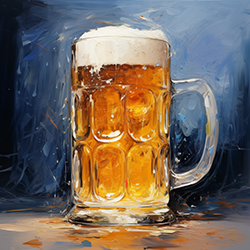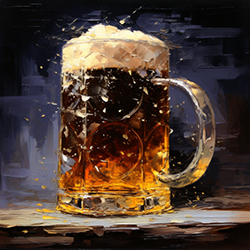The Yeast Chronicles: A Deep Dive into Top and Bottom Fermenting Yeasts in Home Brewing
Posted by Matteo Lahm on 10th Jul 2023
Hello, fellow brew enthusiasts! Today, we're diving deep into the frothy world of beer making, specifically focusing on the unsung heroes of the process - yeasts. Yes, you heard it right! These microscopic fungi are the secret agents behind your favorite brews. So, let's unravel the mystery of top and bottom fermenting yeasts and how they shape your beer's character.
Our tale begins with two protagonists - Saccharomyces cerevisiae (top fermenting yeast) and Saccharomyces pastorianus (bottom fermenting yeast). Imagine them as two master chefs, each with their unique culinary style and preferred ingredients, crafting distinct flavors and aromas in your beer.

Saccharomyces cerevisiae, our top fermenting yeast, has a rich history that dates back thousands of years. This yeast is a true globetrotter, having been used in fermentation processes across the world, from the ancient Egyptians brewing beer to the Romans making wine. It's believed that this yeast was first domesticated for brewing beer, given the archaeological evidence of beer brewing in ancient civilizations. Over time, different strains of Saccharomyces cerevisiae have been developed, each with its unique characteristics, contributing to the diverse range of ales, stouts, porters, and wheat beers we enjoy today.
On the other hand, Saccharomyces pastorianus, our bottom fermenting yeast, has a more recent and somewhat mysterious origin. This yeast is a hybrid, a combination of Saccharomyces cerevisiae and another yeast species, Saccharomyces eubayanus. The latter was only discovered in the wild in 2011, in the beech forests of Patagonia, despite its hybrid, Saccharomyces pastorianus, being used in brewing for centuries. It's believed that Saccharomyces eubayanus somehow made its way from South America to Europe, where it hybridized with Saccharomyces cerevisiae to create the lager-brewing yeast we know today. This yeast's ability to ferment at cooler temperatures revolutionized beer brewing, leading to the crisp, clean lagers and pilsners that are popular worldwide.
The development and cultivation of these yeast strains are a testament to the ingenuity and adaptability of brewers throughout history. From ancient civilizations to modern breweries, these yeasts have been harnessed and honed to create a myriad of beers, each with its unique flavor profile and character. So, the next time you sip on your home-brewed beer, take a moment to appreciate the remarkable journey of the yeasts that made it all possible.
Top fermenting yeast, true to its name, loves to frolic at the top of your brew during fermentation. This yeast is a bit of a heat-seeker, favoring warmer temperatures between 15-24°C (59-75°F). Picture it as your friend who thrives in the summer heat, full of energy and character. This yeast is typically associated with ales, porters, stouts, and wheat beers.
Ales, brewed with top fermenting yeast, are known for their wide range of flavors and aromas, from fruity and spicy to malty and bitter. Porters and stouts, on the other hand, offer a rich tapestry of dark, roasted flavors like chocolate, coffee, and caramel. Wheat beers, another top-fermenting favorite, are often light and refreshing with notes of banana and clove.

On the flip side, bottom fermenting yeast is the cool, composed type. It prefers chillier temperatures, around 7-13°C (45-55°F), and settles at the bottom of the fermentation vessel. Think of it as your friend who relishes a serene winter evening by the fireside. This yeast is typically used in lagers and pilsners, contributing a clean, crisp, and smooth character to your beer.
Lagers, crafted with bottom fermenting yeast, are celebrated for their clean and balanced flavor profile, often showcasing a subtle sweetness from malt balanced with a light hop bitterness. Pilsners, a type of lager, are known for their golden color, crisp taste, and floral, spicy hop character.
Let's explore some of the commercial yeast strains offered by Lallemand, Omega, and White Labs that are popular among home brewers and professional breweries alike.
Lallemand:
1. Top Fermenting Yeast: Lallemand's "London ESB" is a classic example of a top fermenting yeast. It's perfect for brewing traditional English ales, providing a balanced mix of fruity and malty flavors.
2. Bottom Fermenting Yeast: Lallemand's "Diamond Lager" yeast is a bottom fermenting strain that's ideal for brewing a wide range of lagers and pilsners. It offers a clean, crisp finish that allows the malt and hop flavors to shine.
Omega Yeast Labs:
1. Top Fermenting Yeast: Omega's "British Ale I" (OYL-006) is a top fermenting yeast that's great for a variety of English style ales. It produces a slight hint of butterscotch and a mild fruitiness.
2. Bottom Fermenting Yeast: Omega's "Bayern Lager" (OYL-114) is a bottom fermenting yeast that's perfect for brewing traditional Bavarian lagers. It provides a clean, malty finish with a balanced aroma.
White Labs:
1. Top Fermenting Yeast: White Labs' "California Ale Yeast" (WLP001) is a top fermenting yeast that's versatile and can be used in a variety of beer styles. It's known for its clean, well-balanced and neutral flavor profile.
2. Bottom Fermenting Yeast: White Labs' "German Lager Yeast" (WLP830) is a bottom fermenting yeast that's ideal for brewing traditional German lagers. It offers a clean, crisp finish and accentuates the malt character.
Remember, the choice of yeast can significantly influence the flavor, aroma, and overall character of your beer. So, choose wisely!
Now, you might ask, "Can a beer use both yeasts?" Absolutely! Hybrid beers, like California Common or Kölsch, utilize both yeasts, creating a unique fusion of flavors. Picture it as a culinary feast where both your summer-loving and winter-loving friends contribute their signature dishes. The result? A delightful medley of flavors that's sure to excite your palate.
In conclusion, the choice between top and bottom fermenting yeasts hinges on the style of beer you're aiming to brew and the flavor profile you desire. Remember, brewing is an art, and you, my friend, are the artist. So, experiment, discover, and most importantly, relish the process. After all, the journey is just as rewarding as the destination, especially when the destination is a pint of your own, home-brewed beer. Here's to that!

